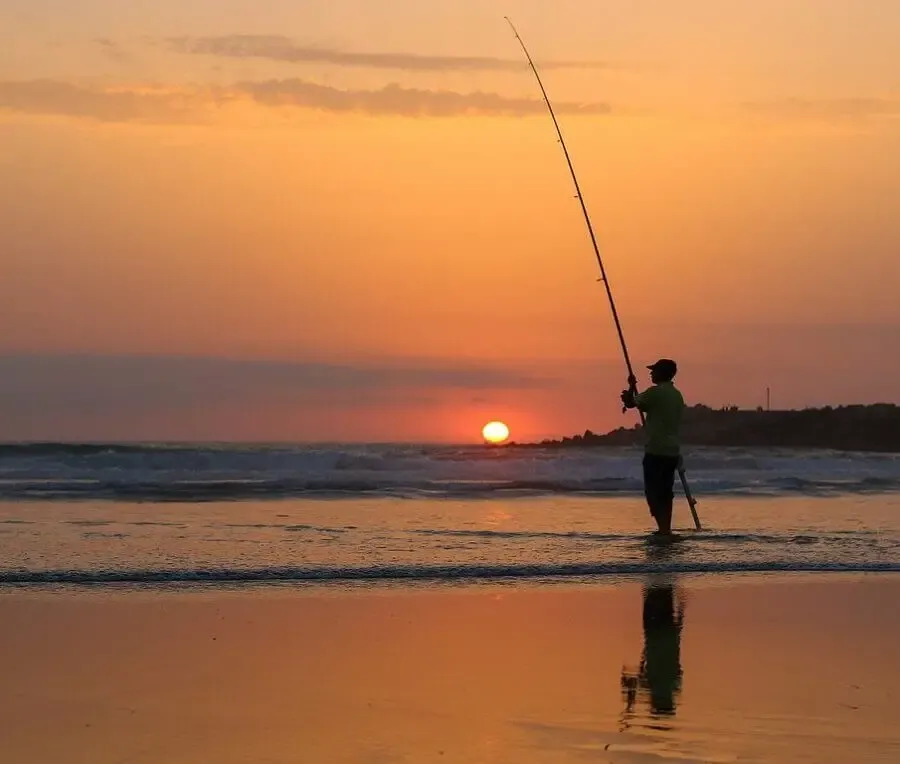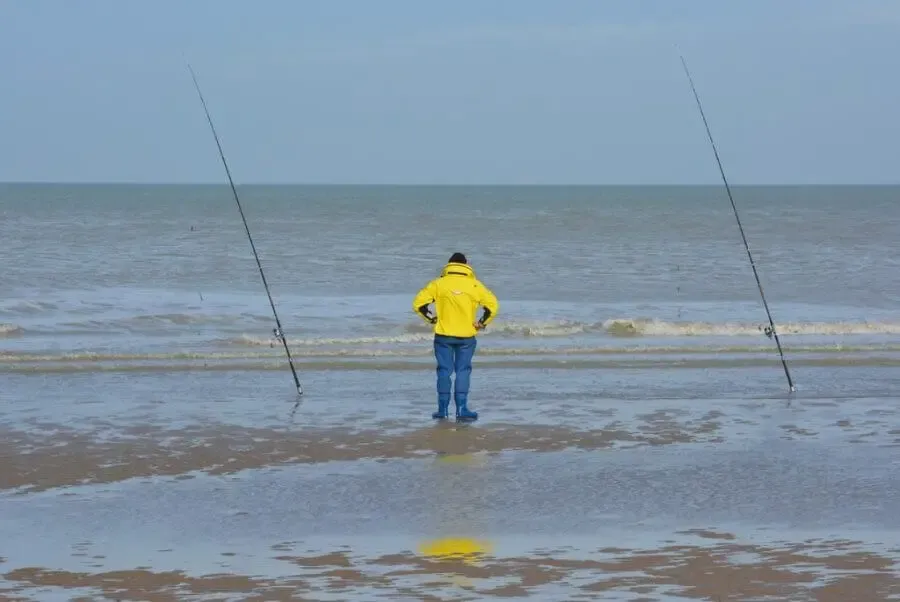The best time of day to go surf fishing is typically two hours before and after dusk, or from dawn until 10 AM.
Surf fishing is a form of fishing that takes place along the shoreline, specifically in the surf zone where waves break onto the beach.
It involves casting a line with live bait or lures into the surf and targeting types of fish that inhabit nearshore or inshore waters. Surf fishing can be done from sandy beaches, rocky shores, or jetties.
What Time of Day is Best to Surf Fish?
The best time to go surf fishing or surfcasting can depend on various factors, including location, tides, and the specific fish species you are targeting.
However, there are a few rules of thumb that can help increase your chances of success:
- Early Morning: Many anglers find that surf fishing in the early morning hours, around sunrise, can be productive. During this time, fish are often more active and feeding as they search for food after a night of rest. The water is typically calmer, and there is less beach activity, providing favorable fishing conditions.
- Late Afternoon to Evening: Another popular time for surf fishing is the late afternoon to evening hours. As the sun starts to set, fish activity can increase again. Many fish species become more active during low-light conditions, and the changing light can trigger feeding behavior.
- Tide Considerations: Pay attention to the tides when planning your surf fishing trip. Some anglers prefer to fish during the incoming or outgoing tide, as moving water can attract fish and increase their feeding activity. High tide can also be a good time to target certain species, as fish may move closer to shore to feed in the shallower water.
Please remember that these are general guidelines, and local conditions and fish behavior can vary. It can be beneficial to research the specific area you plan to surf fish and consider the habits of the target fish species.
Additionally, weather conditions, seasonal variations, and other factors can influence saltwater fishing success.

What Is the Best Time of Year to Surf Fish?
Different fish species have different migratory and feeding patterns throughout the year. Research the specific fish species you are targeting to understand their seasonal behavior. For example, in some regions, certain species may be more active during the spring or fall when they migrate or spawn.
Warmer Months: In many coastal areas, the warmer months of spring, summer, and early fall can offer good surf fishing opportunities. Warmer water temperatures can bring more fish closer to the shore and increase their feeding activity.
Transition Periods: Transition periods between seasons can also be productive for surf fishing. During these periods, fish may be moving in and out of different areas, and their feeding behavior can be heightened.
What is the Best Tide to Fish from Shore?
Many anglers find that the incoming tide can be productive for shore fishing. As the tide rises, it brings in fresh water and nutrients, attracting baitfish and larger predatory fish. During the incoming tide, fish may move closer to shore to feed on the influx of food.
Low tide surf fishing also has its benefits. During low tide, saltwater levels recede, and certain areas that are normally submerged become exposed. This can concentrate fish in deeper pockets, channels, or troughs close to shore. Fish may seek these areas for protection and to access food sources that are more accessible during low tide. Casting your bait or lures in these concentrated fishing spots can increase your chances of catching fish.
Slack tide refers to the period between the incoming and outgoing tides when there is little to no movement in the water. This can be a hard time to fish, as the lack of water movement can result in less active feeding by fish. However, some anglers find that certain species, such as flounder or other bottom-dwelling fish, may still be active during slack tide.
Weather Conditions And Surf Fishing
Wind direction and speed play a crucial role in surf fishing. A light breeze can be beneficial as it helps create ripples on the water’s surface, which can attract fish. However, strong winds can create rough surf and make casting and line management challenging.
It’s generally best to fish when the wind is moderate and blowing in a direction that allows for comfortable casting and presentation of baits or lures.
Cloudy or overcast conditions can create a more favorable fishing environment. Fish may feel more secure and venture closer to the shore to feed when the sun is not as bright or intense. Additionally, reduced visibility can make it easier for predatory fish to ambush their prey.
Light rain or drizzle can be beneficial for surf fishing, as it can create surface disturbance and wash nutrients into the water, attracting fish. However, heavy rain can result in muddy or turbid water conditions, making it more challenging to entice fish to bite.
Is Surf Fishing Better Before or After a Storm?
Surf fishing can be productive both before and after a storm, but the timing and conditions can vary.
As a storm approaches, the barometric pressure typically begins to drop. Some surf anglers believe that fish can become more active and feed more aggressively before a storm as they sense the changing pressure. This can create a favorable fishing window.
Ultimately, the best time to surf fish before or after a storm can depend on various factors, including the specific location, target fish species, and the severity of the storm.

Does Water Temperature Affect Surf Fishing?
Water temperature is an important factor in surf fishing as it influences the behavior and feeding patterns of fish.
Different species of fish have preferred temperature ranges in which they are most active and receptive to feeding. Some species thrive in warmer water, while others prefer cooler temperatures. Understanding the temperature preferences of your target fish species can help you plan your surf fishing trips accordingly.
Many warm-water species, such as snook, tarpon, and redfish, are most active and receptive to feeding when the water temperature ranges from 70°F to 85°F (21°C to 29°C). These species are often prevalent in tropical or subtropical coastal areas.
Cold-water species like striped bass, bluefish, and winter flounder prefer cooler water temperatures. They are easier to find and catch when the water temperature ranges from 50°F to 70°F (10°C to 21°C). These species are commonly found in regions with colder coastal waters.
During the transition between seasons, in the spring and fall, when water temperatures are in the range of 60°F to 70°F (15°C to 21°C), various fish species can be more active and present in the surf zone.
To Sum Up
Surf fishing can be a great activity during the warmer months of the year. The best time for surf fishing is during the early morning or late evening when the tide is low. This is when the fish tend to be more active and feeding closer to shore. Also, check the local weather conditions before heading out, as rough waves and strong winds can make surf fishing dangerous.
You can also try surf fishing during high tide as this is when the fish tend to be closer to shore. Remember always to follow any local regulations and obtain any necessary licenses before surf fishing.
Also, check our article on the best locations to surf fish in New Jersey



